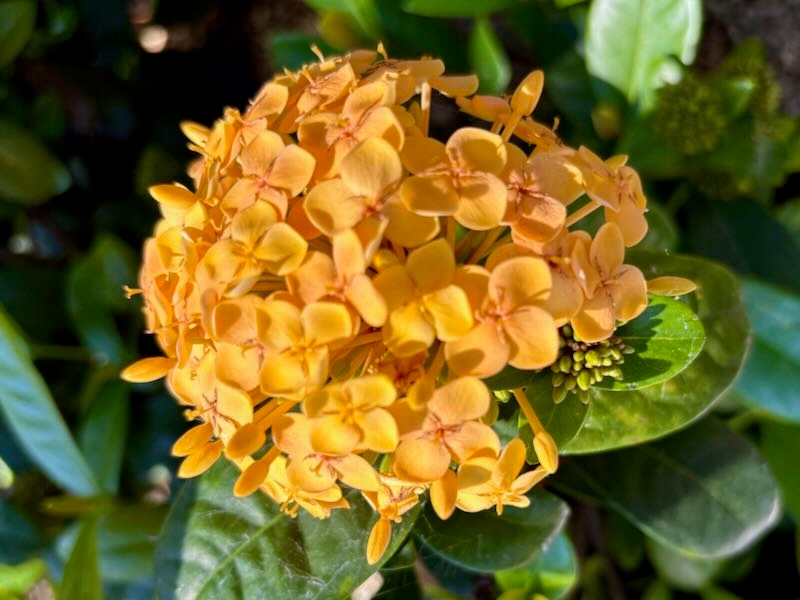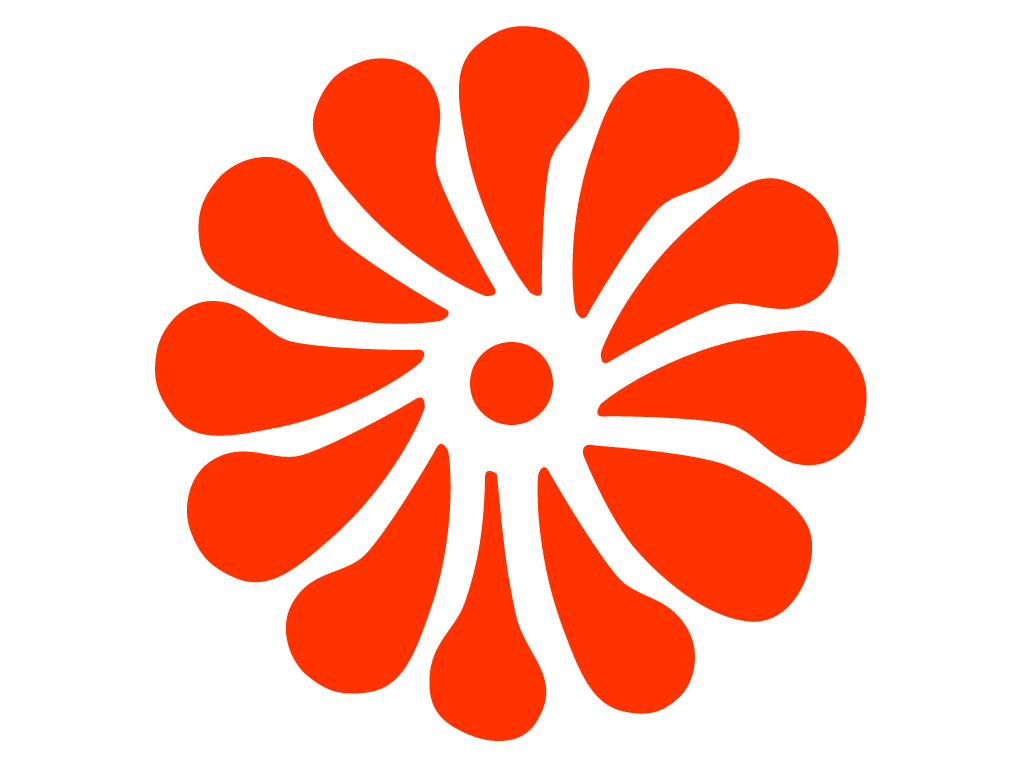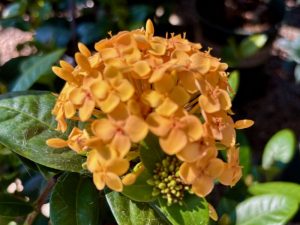Sunset Glow, Year-Round: Grow Ixora ‘Sunset’ For Reliable Peach-Yellow Color
Ixora ‘Sunset’ starts strong and keeps going. Sunset Ixora, also sold as Yellow Peach Ixora, forms a dense, rounded evergreen shrub that covers itself in butter-yellow to peach flower clusters through warm weather. The foliage emerges bronze, matures to glossy olive green, and stays lush when you give the plant warmth, light, and acidic, well-drained soil. As a member of the coffee family Rubiaceae, Ixora carries the same clean, tidy look gardeners love in gardenias and coffee plants, yet it brings brighter color and longer bloom. Plant it as a low hedge, place it in a large container by the patio, or tuck it into mixed borders where you need a sun-loving, compact flowering shrub.
Ixora ‘Sunset’ in brief (and why it works in real gardens)
Ixora ‘Sunset’ grows into a low, oval mound that typically reaches 0.75–0.9 m (2½–3 ft) tall and 0.9–1.2 m (3–4 ft) wide in home landscapes. In very warm coastal or tropical sites, older plants can push a bit larger, yet they keep a compact, multi-branched outline. The flowers appear in rounded heads, 10–15 cm (4–6 in) across, each head made of dozens of starry, four-petaled florets that open buttery yellow and then warm toward peach or soft apricot. Because each stem often holds two to three heads, the shrub reads as a solid mass of color from late spring into autumn, and even longer wherever nights remain warm.
Gardeners choose Sunset Ixora because it cooperates. It tolerates heat and humidity, accepts morning sun with light afternoon shade, and rebounds quickly after light trims. Furthermore, it plays well with design partners. Pair it with silver foliage for contrast, or echo its tones with coral and apricot companions. Since the shrub stays neat without harsh shearing, it looks good close to entries, along walkways, and at the front of borders.
Botanical background and names you may see
The genus Ixora includes more than 500 tropical shrubs native to tropical Asia and nearby regions. You will most often see Ixora coccinea and its hybrids in the trade. Cultivars in peach-yellow shades circulate under several catalog names; thus, you may encounter Sunset Ixora, or Yellow Peach Ixora on plant tags. These selections share the same core traits: dense, evergreen foliage; bronze new growth; and generous clusters of yellow-to-peach flowers through warm seasons. Ixora ‘Sunset’, sometimes sold under names like Sunset Ixora or Yellow Peach Ixora, is a compact tropical shrub valued for its glowing clusters of yellow-to-peach blooms and glossy evergreen foliage.
Flower and foliage details of Ixora ‘Sunset’
The flower heads sit proudly above the leaves on short, sturdy stems. Each head holds many slender, tubular florets that flare into clean, star-shaped petals. Fresh clusters open butter yellow, then shift toward peach, apricot, or soft coral as they age. The tonal range makes the shrub read dynamic from week to week. While most plants carry little fragrance, the color show does the heavy lifting, especially against deep green backgrounds.
The foliage emerges bronze and soon turns olive to medium green with an attractive gloss. Leaves are opposite, elliptic to ovate, and typically 7–10 cm (3–4 in) long. Because growth stays tight at the nodes, the plant builds a naturally dense, rounded habit without constant clipping. That density also helps cover the lower stems, which keeps the shrub looking full to the ground.
Flowering season, performance, and what controls the show
In warm regions, Sunset Ixora can flower nearly year-round. In most temperate sites, it blooms from late spring to early autumn, then slows when night temperatures drop below 21°C (70°F). The plant sets new clusters on fresh growth; therefore, steady warmth, regular moisture, and light feeding keep the cycle moving. Remove faded heads by pinching just below the cluster, and you will see new shoots push within two to three weeks during peak season.
Ixora ‘Sunset’ growth habit and size in different settings
Expect a compact mound in landscapes—again, about 0.75–0.9 m (2½–3 ft) tall and 0.9–1.2 m (3–4 ft) wide. In large containers, growth is similar when you size the pot correctly and feed on schedule. In coastal, frost-free climates, older plants may reach 1.2–1.5 m (4–5 ft), yet they still present as rounded shrubs rather than lanky screens. Use this scale to create continuous hedging along paths and to anchor corners of small patios without overwhelming the space.
How to grow Ixora ‘Sunset’ (actionable steps that work)
Light
Give Sunset Ixora full sun to light shade. Aim for 6–8 hours of direct light daily for the strongest flowering. In hot inland zones, morning sun with dappled afternoon shade prevents leaf scorch and extends bloom life. Indoors or on covered porches, position containers by a south- or west-facing window and rotate the pot a quarter turn each week for even growth.
Soil
Plant it in acidic, well-drained, organically enriched soil. A target pH of 5.0–6.0 keeps nutrients—especially iron—available. Blend 20–30% compost into native soil at planting, and add pine bark fines for structure. In containers, use a high-quality, peat-based mix labeled for acid-loving plants. Good drainage matters; soggy soil leads to root issues, yet bone-dry media stalls flowering.
Watering
Water deeply and consistently during establishment. In the ground, supply about 10–12 L (2½–3 US gal) per plant once or twice a week in dry spells, adjusting for heat and rainfall. Let the top 2–3 cm (¾–1¼ in) of soil dry slightly between irrigations. In pots, water until it flows from the drainage holes, then empty saucers. During peak bloom, never allow the root ball to dry completely; stress halts bud formation.
Fertilizing
Feed like you would azaleas or gardenias. In early spring, apply a slow-release, acid-formulation fertilizer at label rates. Follow with a light top-up after the first heavy flush of flowers in midsummer. If foliage turns yellow with green veins—classic iron chlorosis—treat quickly with a chelated iron drench and check pH. Avoid high-phosphorus feeds; balanced or slightly nitrogen-forward blends support steady growth and rebloom.
Temperature and humidity
Sunset Ixora thrives in warm, humid air. Ideal daytime temperatures run 24–32°C (75–90°F), with nights above 18–21°C (65–70°F). The shrub is frost-tender; exposure below 1–2°C (34–36°F) can defoliate or kill top growth. In marginal climates, grow it in containers so you can move the plant indoors before cold snaps. Indoors, increase humidity with a tray of pebbles and water or a room humidifier during winter heating.
Spacing and planting
For hedges, space plants 60–75 cm (24–30 in) apart center-to-center. For specimen shrubs, allow 90–120 cm (36–48 in). Dig a hole twice as wide as the root ball and just as deep. Set the crown level with the surrounding soil. Backfill, firm gently, and water to settle. Add a 5–7 cm (2–3 in) mulch of shredded bark or pine needles, keeping mulch 5 cm (2 in)away from stems.
Containers
Pick a pot at least 35–40 cm (14–16 in) across for a young plant; step up to 45–50 cm (18–20 in) as it fills out. Ensure large drainage holes. Use a peat- and bark-based mix blended for acid-loving plants. In the growing season, apply a dilute liquid feed every 4–6 weeks if you prefer liquid programs over slow-release granules. Outdoors, place the pot in bright sun and turn it a quarter turn monthly.
Pruning and deadheading
Prune lightly and deliberately. After a main flush, clip off spent heads just below the cluster to trigger branching and new buds. Once a year—ideally late winter to very early spring—shorten the longest shoots by 10–20 cm (4–8 in) to maintain the mound. Avoid frequent shearing of tips; constant tip cuts remove forming buds and reduce flowering. Remove any twiggy growth shading the plant’s center to improve airflow.
Overwintering in cool regions
In USDA Zones 9–11, Sunset Ixora behaves as an evergreen flowering shrub outdoors. In cooler zones, treat it as a container perennial. Before nights drop below 13°C (55°F), move pots indoors to bright light. Water sparingly, keeping the mix just barely moist. Resume stronger watering and feeding when new growth appears in spring, then acclimate the plant back outdoors over 7–10 days.
Propagation of Ixora ‘Sunset’ for home gardeners
You can propagate Sunset Ixora from semi-hardwood cuttings once stems have matured slightly, usually late spring through summer. Take 8–10 cm (3–4 in) tip cuttings, remove the lower leaves, and dip the base in rooting hormone. Insert into a tray of 50% perlite and 50% peat or coco coir. Maintain bright, indirect light, high humidity, and bottom warmth around 24°C (75°F). Roots form in 3–6 weeks, after which you can pot up gently. Seeds exist but rarely come true to the exact flower shade and can take longer to reach flowering size; therefore, cuttings are the practical choice for home growers.
Pests and diseases on Ixora ‘Sunset’ (and how to prevent them)
Healthy plants resist most problems; still, regular checks help you act early. Scale insects and mealybugs settle on stems and leaf undersides, leaving sticky honeydew and encouraging sooty mold. Wipe light infestations with alcohol-dampened cotton or spray insecticidal soap weekly until clear. In hot, dry spells, spider mites can stipple leaves; rinse the canopy with a firm spray and increase humidity, then use horticultural oil if needed. Aphids congregate on soft tips; a sharp water blast often resolves the issue.
Leaf spots, especially Cercospora and Colletotrichum, show up during prolonged humidity. Improve airflow with light thinning, water at soil level, and keep mulch tidy. If spots persist, rotate a labeled copper or bio-fungicide according to directions. Root problems usually trace back to poor drainage. Keep the soil evenly moist, never saturated, and size the pot correctly so media dries predictably between waterings.
Yellowing leaves with green veins point to chlorosis, a pH or iron-availability problem. First, confirm pH 5.0–6.0. Next, apply a chelated iron drench and switch to an acid-formulation fertilizer. If your tap water runs very hard, consider rainwater or distilled water for containers to avoid raising pH over time.
Landscape uses and design ideas with Ixora ‘Sunset’
Use Sunset Ixora where people will see it every day. Along walks and entryways, it brings neat structure and cheerful color without fussy grooming. In mixed borders, echo its peach notes with Coral Bells (Heuchera) in warm shades or contrast it with Silver Artemisia and Blue Salvia. In tropical schemes, partner it with Croton, Hibiscus, Plumbago, Lantana, and Cordyline for bold texture play. Because the shrub tops out around 3 ft (0.9 m) in many gardens, it also edges pool decks and patios without blocking views. For containers, place one plant in a 45–50 cm (18–20 in) pot as the “thriller,” then ring it with compact fillers in creamy or soft blue shades to frame the warm blooms.
Environmental tolerances and limitations gardeners should know
Sunset Ixora loves heat and humidity and tolerates coastal exposure when you shield it from the harshest wind. It handles short dry periods once established, yet it flowers best with steady moisture. Alkaline soils slow growth and wash out color, so address pH upfront. The plant is frost-tender; cold snaps cause leaf drop and tip dieback. Fortunately, it rebounds fast after warmth returns, especially if roots stayed healthy. In midday scorch zones, root stress in black plastic pots can trigger leaf edge burn; switch to larger, light-colored containers and water in the cool morning hours.
Cut flowers and everyday maintenance
You can cut Sunset Ixora for short-stem bouquets. Harvest in the cool morning when heads are half to fully open. Strip lower leaves and place stems immediately into lukewarm water. Clusters last 4–6 days indoors. In the garden, keep the shrub photo-ready with quick deadheading after each flush, a fresh mulch layer each spring, and a midseason light feed. These small, regular tasks matter; they keep new growth moving and color coming.
Troubleshooting quick answers for Ixora ‘Sunset’
If leaves yellow despite watering, check pH and apply chelated iron. And if buds drop, look at temperature swings and soil dryness between irrigations. But if flowering slows, increase sun exposure and deadhead spent clusters, then apply a light feed. If the shrub looks leggy, trim stems back by 10–15 cm (4–6 in) after a flush to reset the outline and stimulate branching.
Where Ixora ‘Sunset’ fits in your climate
Sunset Ixora thrives outdoors year-round in USDA Zones 9–11. Gardeners in Zone 9 should protect it during rare radiational frosts with frost cloth and a quick pre-freeze watering. In Zones 8 and colder, grow it in a movable container. Bring the plant indoors when nights dip below 13°C (55°F). Place it in bright light, water sparingly, and return it outside after the danger of frost passes. Indoors, it doubles as a houseplant if you provide strong light and regular misting or a humidifier.
A note on wildlife and safety around the home
Sunset Ixora’s bright clusters draw butterflies and bees, adding movement and life to sunny spaces. Deer pressure varies by region; many gardeners report light browsing at most, likely because the foliage is a bit leathery. As with any ornamental, discourage pets or children from chewing leaves or stems. There are no widespread reports of severe toxicity for Ixora species, yet prudent placement and supervision always make sense in family gardens.
Final take: plant it once, enjoy it for years
Choose Ixora ‘Sunset’ when you want reliable, warm color from a shrub that fits small gardens and large patios alike. Plant it in acidic, well-drained soil. Place it where it gets strong light. Water deeply but not constantly, and feed lightly like you would other acid-loving shrubs. Then keep it tidy with gentle deadheading and a short annual trim. With those simple steps, Sunset Ixora delivers months of butter-yellow to peach bloom, glossy evergreen foliage, and an easy, polished look that belongs in every warm-climate planting plan.



